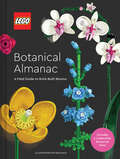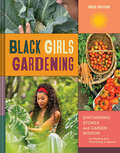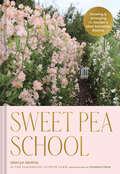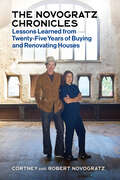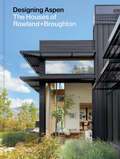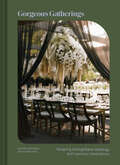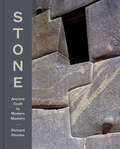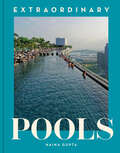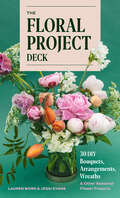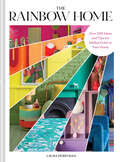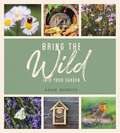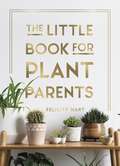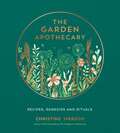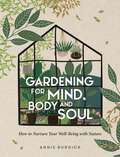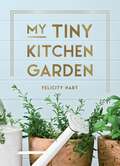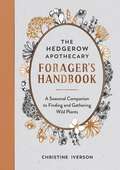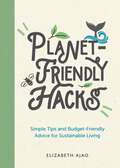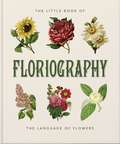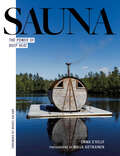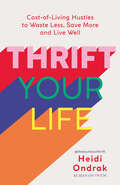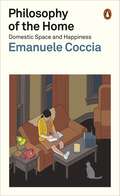- Table View
- List View
LEGO Botanical Almanac: A Field Guide to Brick-Built Blooms
by LEGOBotany in bricks! Take a closer look: This intricately illustrated compendium of flowers and plants has a LEGO® twist—the blooms are built of bricks! Inspired by the bestselling LEGO Botanical sets, this almanac combines floral facts, hand-drawn botanical illustrations, and exclusive stories from the LEGO set designers themselves, plus a bonus removable flower print to display.Inspired by scientific drawings of flora, the beauty is in the details of the singular LEGO® Botanical Almanac. Each page presents a deeper look into a stunning LEGO bloom, succulent, or plant—from garden varietals to the exquisitely exotic. Like traditional botany illustrations, these LEGO flowers are presented as stunning works of art and detailed dissections of real species. Dip in and out to learn about each plant and discover behind-the-scenes details of how LEGO set designers turned iconic bricks into captivating natural forms. A perfect gift for LEGO fans and unlike any other book before it, the LEGO® Botanical Almanac highlights where art meets science and building meets play—a true celebration of the boundless creativity of the LEGO brand.LEGO, the LEGO logo, and the Brick and Knob configurations are trademarks of the LEGO Group. ©2024 The LEGO Group. All rights reserved.EXCLUSIVE REMOVABLE PRINT INCLUDED: Tucked in the back of the book is a removable print featuring a hand-drawn illustration from the book. Frame and hang it on your wall to admire—and spark your creative thinking—every day. UNIQUE FAN ARTIFACT: With beautifully rendered art and a sophisticated package that mimics a true scientific work, this almanac is an unexpected gift for the LEGO fan that has everything. Share the LEGO fandom with this surprisingly beautiful keepsake. A BRAND YOU LOVE AND TRUST: For decades, the LEGO brand has inspired billions of people to stretch the limits of their imaginations and explore the power of play. Discover a new side of the LEGO universe with this beautiful LEGO book.EXCLUSIVES FROM THE LEGO DESIGNERS: The book features behind-the-scenes interviews, stories, and fun facts, offering a unique window into the creative process of developing a LEGO set.Perfect for:LEGO fansLEGO builders who purchased the LEGO Botanical setsGardeners and fresh-cut flower loversPeople interested in home décor and looking for a beautiful flower book to displayPeople fascinated by scientific botanical drawingsMother’s Day, housewarming, anniversary, birthday, Valentine’s Day, or Galentine’s Day gifting
Black Girls Gardening: Empowering Stories and Garden Wisdom for Healing and Flourishing in Nature
by Amber GrossmanA visual celebration of Black women and their gardens, filled with inspiration, stories, and the healing magic of gardening, based on the popular Instagram account BlackGirlsGardening.“Arranged into themed sections on gardening with kids, growing for the kitchen, and community farming, this book provides both the inspiration and instruction to join the ranks of the badass, trowel-wielding women featured in its pages.“ —Oprah Daily “This is a gardening book for all walks of life and any experience level. Each woman in Black Girls Gardening shares a unique gardening journey, but they all demonstrate how a gardening practice has the power to heal, empower, educate, and connect.” —Essence Through first-person narratives and arresting photography, this unique gardening book profiles women who demonstrate how a gardening practice has the power to heal, empower, educate, and connect. Thirty-one compelling personal stories about creating backyard, flower, and vegetable gardens, participating in community gardens, and gardening with kids are included. Sidebars offer advice on composting, pest control, must-have tools, greenhouse gardens, and more. In a beautiful, chunky package that can be read cover to cover or displayed on a coffee table, Black Girls Gardening makes a lovely gift for aspiring and practicing Black women gardeners, first-time homeowners, parents who garden with their kids, and women of all ages who enjoy sinking their hands into the soil.GARDENING AS EMPOWERMENT: With stories on starting a garden from seed, building your own vegetable and flower beds, growing your own food, connecting with a community, and showing your kids the power and joy that come from these experiences, this uplifting book demonstrates how gardening empowers women and green thumbs of all ages and levels. HEALTH BENEFITS: Gardening is good for you, and it’s a lifelong hobby! Spending time outside is an excellent way to relieve stress and anxiety, and gardening is an accessible and increasingly common pastime that provides respite from our indoor, online, sedentary lives. This book celebrates gardens as a sanctuary, a source of solace and joy, and a place for self-discovery and connection. CELEBRATES DIVERSITY: This uniquely inspiring nature and gardening book highlights stories from Black, biracial, and multiracial women, an underrepresented audience in mainstream gardening, nature, and outdoor media.Perfect for: Self-care gift or self-purchase for Black women, ages 18 - 50+ Gift-giving for Mother’s Day, birthday, housewarming, or retirement Women gardeners and aspiring green thumbs Garden admirers and nature enthusiasts First-time homeowners who want to plant a garden Followers of @BlackGirlsGardening Fans of Nature Swagger, Wild at Home, My Beautiful Black Hair, She Explores
Sweet Pea School: Growing & Arranging the Garden’s Most Romantic Blooms
by Marryn MathisFrom experienced flower farmer and reigning "Sweet Pea Queen" Marryn Mathis comes this gorgeous, instructive guide to growing and harvesting your own sweet peas. “If you don’t have sweet peas in your garden (yet), having this book on your coffee table is the next best thing.” —Oprah Daily "Sweet Pea School reveals the passion and knowledge of an experienced flower farmer who respectfully acknowledges the work of plantspeople who have grown this beloved bloom into the flowering darling of yesterday, today and tomorrow." —Seattle TimesWith their delicate petals, whimsical vines, and intoxicating scent, sweet peas are some of the most nostalgic and beloved blooms—and they’re easy to grow. Known for the vibrant kaleidoscope of varieties she cultivates on her Washington farm, Marryn Mathis shares her deep knowledge and passion for sweet peas, taking you on an informative journey through her fields and teaching you how to plant, grow, harvest, and arrange a bounty of spectacular flowers. Inspired by Mathis's popular "Sweet Pea School" workshops, this gardening book is a master class in sweet peas, sharing: The history of this timeless flower Best practices for planting and growing An overview of popular varieties Step-by-step instructions for creating magnificent floral arrangements Plus, Mathis’s inspiring personal story of becoming a flower farmer and building The Farmhouse Flower Farm Overflowing with stunning photos of colorful varietals, romantic bouquets, and gardens in full bloom, this modern guide to sweet peas is a must-have resource for gardeners, farmers, and florists of all levels, as well as designers and creatives eager for inspiration.EXPERT AUTHOR: Marryn Mathis (a.k.a. the Sweet Pea Queen) is a champion of and authority on sweet peas. Her Farmhouse Flower Farm is one of the foremost flower farms in the United States, with a robust mail-order business, social media following, and online and in-person workshops that regularly sell out. The farm was featured on the Magnolia Network’s Growing Floret. COMPREHENSIVE FLOWER GUIDE: Sweet peas are beloved for their romantic petals, intoxicating scent, and range of vibrant colors, from pale peach to deep mauve. They're easy to grow—in pots or beds, for cut flowers or your garden—and they attract beneficial pollinators. Sweet Pea School is full of actionable advice and step-by-step instructions for planting, growing, harvesting, and arranging sweet peas, no matter your experience level. Flower farmers and gardeners looking for a hardworking resource and growing guide on sweet peas will find everything they need here. FLOWER LOVERS’ GIFT: Brimming with gorgeous imagery of sweet peas on the vine, the farm at sunrise, and stunning floral arrangements, this volume offers an enchanting peek into the life of a flower farmer. It makes an inspired gift for hobbyists as well as experienced florists and gardeners. Flower lovers, design aficionados, and decorators will delight in the beauty and creative fodder in these pages. Display it on a coffee table alongside a vase or a beautiful tray.Perfect for: Gardeners of all levels Flower farmers, growers, and florists Followers of @thefarmhouseflowerfarm and those who have attended their workshops or buy their seeds People who enjoy flower arranging Interior designers and artists look
The Novogratz Chronicles: Lessons Learned from Twenty-Five Years of Buying and Renovating Houses
by Robert Novogratz Cortney NovogratzHusband and wife design duo Robert and Cortney Novogratz share their trade secrets and personal stories from over twenty-five years of buying, selling, and fixing up homes.Robert and Cortney Novogratz, stars of HGTV’s Home by Novogratz and Bravo’s 9 by Design, have transformed fabulous properties across the U.S. and around the world, including Hotel Dylan (Woodstock, NY), the Bungalow Hotel (Long Branch, NJ), and Timber Cove (Sonoma, CA), to name a few. They've also partnered with many celebrities and top retailers and had their work profiled in major national media outlets, from The New York Times to Architectural Digest, all while raising their family of seven children. They not only know how to run a successful and innovative design business but also how to balance work, family, and fun. The Novogratz Chronicles is their most intimate and personal book to date, taking readers on their journey from their first house renovation project in Chelsea in the 1990s to their latest home in Greenwich Village and projects in Los Angeles, Brazil, and the Berkshires. Eleven chapters explore and share their path to success, from thinking outside the box when financing, to building the right renovation team, to developing a design aesthetic and trusting your design instincts, interspersed with personal anecdotes and stories from their hands-on experiences. DIYers, HGTV fans, weekend warriors, and anyone interested in buying, selling, and renovating houses and spaces will love reading The Novogratz Chronicles and discovering the expertise that lies beyond their renowned how-to decorating prowess to inform and inspire their own renovation dreams and endeavors.
Designing Aspen: The Houses of Rowland+Broughton
by John Rowland Sarah BroughtonIn this luxurious and aspirational home design book, the founders of renowned Colorado firm Rowland+Broughton share a selection of their extraordinary residential projects, with Aspen and the Rocky Mountains as the dazzling backdrop.Rowland+Broughton is known for shaping the town of Aspen with their visionary work in urban design and historic preservation. Here, founders John Rowland and Sarah Broughton showcase ten spectacular residences in Aspen and the Rocky Mountains created by their innovative and talented firm.With beautiful photography throughout, Designing Aspen includes a range of houses, from Mountain Retreat, a modern lodge-style home located at the base of Aspen Highlands, to Meadow House, positioned at the edge of a meadow amid an existing forest of spruce and evergreens, and from Art Barn, a residence with the specific purpose of displaying art, to Bagua, a Zen mountain retreat. Also featured are essays about Aspen and its history and relevance; the importance of historic preservation; client relationships; and the philosophy of the firm; and a foreword by Tom Kundig. Perfect for lovers of home design and architecture, anyone who aspires to build or decorate a house in the mountains, and visitors and residents of Aspen enthralled by its charms, this makes a beautiful coffee table book and a captivating volume of residential design expertise and inspiration.
Gorgeous Gatherings: Designing Unforgettable Weddings and Luxurious Celebrations
by Alison HotchkissFilled with inspiration for your next party, this stunning lookbook combines beautiful imagery of celebrations around the world with practical advice for designing your own unforgettable events.Travel from the coast of Japan to the beaches of Mexico, from New York City to the Utah desert, and discover how a professional planner designs exquisite celebrations inspired by the world’s most stunning destinations. In these pages, Alison Hotchkiss—named best wedding planner by Vogue, Harper’s Bazaar, and Goop, and widely recognized in the event industry as a creative luminary—reveals the process of choosing the color palette, flowers, paper goods, textiles, menus, music, and other travel-inspired details to create memorable parties with a sense of place. Helpful tips and how-tos for designing bespoke weddings and events are woven throughout, such as:Making a mood boardConstructing a floral chandelierChoosing your first dance songDealing with inclement weatherCrafting a sweet send-off giftAnd so much moreBrimming with breathtaking photos and insightful guidance, Gorgeous Gatherings is essential inspiration for brides and hostesses and a blissful armchair escape to faraway places and fabulous soirees.RENOWNED AUTHOR: Alison Hotchkiss is one of the world's most talented and renowned wedding and event planners. Her co-writer, Elizabeth Graves, is the editor-in-chief of Martha Stewart Living and the former editor-in-chief of Martha Stewart Weddings. They've distilled their combined decades of experience into this stunning guide, ensuring it's packed with beautiful details and essential party-planning wisdom.ASPIRATIONAL AND INSPIRATIONAL IDEAS: Jaw-dropping photography makes this a fun-to-flip-through lookbook, but the pages are also filled with practical advice and achievable how-tos for replicating aspects of these amazing events at home. Gorgeous Gatherings makes table design and entertaining feel fun and inspiring to hostesses, décor enthusiasts, flower lovers, brides, and anyone who wants to elevate their gatherings. BEAUTIFUL TO GIFT AND DISPLAY: A gorgeous event planning book with a textured cover and tip-on photo, this makes a lovely gift for a hostess or bride-to-be who will enjoy getting lost in all the alluring images. With tons of flower photos and tablescaping tips, it also makes a lovely gift alongside a vase, set of coupe glasses, or beautiful table linen. Display this stunning book on a coffee table next to Arranging Things, Call It Home, and Natural Tables.PARTIES AND WEDDINGS: This book offers advice for planning weddings, anniversary parties, birthday celebrations, garden parties, showers, and fetes for any special occasion.Perfect for:Brides, mothers of brides, engaged couplesShoppers looking for an engagement or housewarming giftHosts, hostesses, and anyone who likes to entertainReaders of Martha Stewart Living, Real Simple, and The KnotFans of Pacific Natural, Gathering: Setting the Natural Table, Live Beautiful, Platters and Boards, and Call It Home
Stone: Ancient Craft to Modern Mastery
by Richard RhodesIn this perceptive and illustrative look at the expressive and practical use of stone throughout history, Richard Rhodes unlocks the underlying principles of this ancient material—and explains the closely guarded “Sacred Rules” of the Freemasons guild for the first time ever.The relationship between mankind and stone is elemental and deeply ingrained in us all. Stone, after all, has been the primary building material for more than five thousand years of human history, and it continues to record our triumphs and failures. In this searching history, Rhodes—a sculptor, stonemason, and scholar of stonework—explores how stone is best used today and throughout history. Stone presents the closely kept “Sacred Rules” developed over centuries by the medieval Freemason guild, previously available only to the initiated. Here, the rules are explained through historical examples and photographs. In these times of rapid development and expansive urbanization, Rhodes implores us to explore the essential qualities of stone that emerge from the Sacred Rules, not only to rediscover the ancient and traditional knowledge that governed its use for so long but also to find a roadmap for how future generations might thoughtfully recapture the power this material offers.MOST RENOWNED STONEMASON IN THE U.S.: Richard Rhodes apprenticed as a stonemason in Siena, Italy, after graduate studies at the London Academy of Music and Dramatic Art. As the first non-Italian admitted into Siena’s ancient masonic guild in 726 years, he is known throughout the sculpture and stone community as the “last apprentice.” HISTORICAL EDUCATION: A nationally acclaimed lecturer and educator, Rhodes has shared his deep knowledge of the history of stone and stonemasonry through convention addresses to the American Institute of Architects and the Association of Professional Landscape Designers, a five-lecture educational series to the Institute of Classical Architecture in both New York and San Francisco, and lectures to the Building Stone Institute and many public and private universities. His work has been featured in Architectural Digest, New York Times, Architectural Record, MSNBC, The Globe and Mail, Greenwich Post, Seattle Times, and The Globe and Mail, among many others. EXPERT CONTRIBUTOR: The book includes a foreword by Paul Goldberger, a contributing editor at Vanity Fair and previous architecture critic for both the New Yorker and the New York Times, where he was awarded the Pulitzer Prize. He is the author of many books, including Why Architecture Matters.
Extraordinary Pools
by Naina GuptaA visual feast of fifty wonderfully distinctive and architecturally astounding swimming pools from around the worldExtraordinary Pools is a mosaic of exceptional public and private examples of pools, reasserting the protean quality of the swimming pool as a space of activity, pleasure, and excess. Illustrated with awe-inspiring color photography, it showcases stunning examples of architecturally significant swimming pools around the world, including:Berthold Lubetkin’s modernist Penguin Pool at the London ZooThe world’s largest infinity pool at Marina Bay Sands in SingaporeThe landmark Julia Morgan-designed City Club pool in Berkeley, CaliforniaLuis Barragan's signature L-shaped pools at Cuadra San Cristobal in MexicoAnd many moreWoven throughout are essays by swimmers and architectural experts on the role swimming pools have played in shaping modern culture, from the 1932 Olympics and Mussolini’s campaign to redefine the new Italian Fascist as physically fit, disciplined, and virile to the dawn of circular backyard pools in California that became playgrounds for skateboarders during the great drought of the 1970s. With its lush imagery and lively discussion, Extraordinary Pools will dazzle recreationists and architecture enthusiasts alike.STUNNING PHOTOGRAPHY: Illustrated with full-color images throughout, Extraordinary Pools is an aspirational, covetable volume befitting any design lover's coffee table display.ENDLESSLY FASCINATING: Swimming pools are status symbols and objects of interest regardless of climate or season. Whether they are used for athletic pursuits or the simple joy of relaxing in water, found indoors or out, are kidney-shaped or Olympic-sized, pools are an enthralling source of visual and aesthetic pleasure.EXPERIENCED AUTHOR: Naina Gupta, a practicing architect who teaches at the Architectural Association of the School of Architecture in London, turns her trained eye on a dazzling array of pools to explore their visual impact and cultural significance.Perfect for:Swimmers, beach lovers, and pool enthusiastsCollectors of architecture, design, and home décor booksHost/hostess or housewarming giftArchitectural history buffsPhotography fans and armchair travelers
The Floral Project Deck: 30 DIY Bouquets, Arrangements, Wreaths & Other Seasonal Flower Projects
by Lauren Work Jessi EvansPacked with easy-to-follow instructions, gorgeous photographs, and recipes for 30 breathtaking floral arrangements, this handy DIY deck gives you the power to create floral displays that will elevate any occasion.Design stunning floral arrangements for holiday hosting, special occasions, gifting to friends, or simply making any day a little brighter and more beautiful. This easy-to-use deck includes 30 how-to recipe cards for creating gorgeous seasonal arrangements, including: A lush harvest tablescape A welcoming holiday wreath A summer-sweet centerpiece for al fresco dining A “grateful guest” bundle to present to your host Bouquets for Valentine's Day, Mother’s Day, and more A petite booklet outlines the basics—essential tools and a flower glossary for easy reference—to get you started, and each card features a photo of a flower arrangement and step-by-step instructions. The Floral Project Deck makes it easier than ever for flower lovers to make their own gorgeous designs at home.FLOWER ARRANGING FOR ALL: These flower recipes are uncomplicated, and every card provides clear instructions and a photo, ensuring any hobbyist can easily recreate these beautiful bouquets and bundles regardless of skill level. FLORAL ART THROUGHOUT THE YEAR: A simmer pot to welcome the new year, a pastel bouquet for Mother's Day, a charming flower crown to mark the summer solstice, a colorful kale autumnal centerpiece, a festive holiday wreath: These 30 floral projects incorporate seasonal blooms, ensuring you have a gorgeous arrangement for every time of year. GIFT FOR FLOWER LOVERS: With beautiful flower photography and an eye-catching package, The Floral Project Deck makes a lovely companion for flower enthusiasts and a perfect present for any celebratory occasion.Perfect for: Anyone who likes to arrange flowers Novice or professional florists Gardeners, flower lovers, and nature enthusiasts People who buy blooms at the farmer’s market or grocery store Gift-giving for Mother's Day, birthday, housewarming, or holiday
The Rainbow Home: Over 200 Ideas and Tips for Adding Color to Your Home
by Laura PerrymanBring a rainbow of joy into your life with colorful home design and decor inspiration. The Rainbow Home features hundreds of easy DIYs and tips from leading home influencers for homeowners, renters, and anyone inspired by color.Many homes have color in them, but a rainbow home is one that uses color in a particular way. This could be a bright pop of surprising color, a room that pairs clashing colors, an intense use of pattern, or a clear rainbow effect. The overall feel is that the color is there to bring joy and to create a home that is extremely personal and unique. Like Pinterest at your fingertips, The Rainbow Home is the go-to reference book that makes it easy to define your own rainbow style and add color anywhere in your home. Divided by area (house front and doorways, hallways and stairs, living spaces, kitchens, eating and entertaining, sleeping spaces, bath and relaxation, home offices and craft rooms, storage solutions, and outdoor space), each chapter includes: Lots of clever DIYs, purchasable ideas, and photographic inspiration. An exploration of the three distinct “types” of rainbow colors: dopamine brights (intense bold and joyful colors), playful pastels (nostalgic and sweeter chromas), and uplifting neons (electric and punchy hues). A deeper dive into specific colors, breaking down the benefits of each, how to choose which shade is right for you, and a color pairing guide. Feature profiles on notable décor personalities, taking a peek into their colorful homes and sharing their advice, including such luminaries as Evie Kemp (@eviekemp), Stasia Buckle (@stasiabuckle), Maye Ruiz (@mayeruz), Lizzy Hingham (@lizzyhigham_interiorstyling), Shareen and Martin (@happyvillageinterior), and Sisi Alfred (@homewithsisi). A brilliant interior design coffee table book, The Rainbow Home is outstanding as a self-purchase for color enthusiasts, a housewarming present, or a handy guidebook for designers, stylists, color consultants, decorators, and creatives of all types.THOUSANDS OF DÉCOR IDEAS: Over 600 images with corresponding ideas and tips are included, so you’ll never run out of inspiration for your home. LEADING DÉCOR EXPERTS: This irresistibly aesthetic book features the dazzling homes and interiors of top #rainbowhome influencers who share their seasoned advice for making your home feel fun and colorful. RENTER-FRIENDLY TIPS & TRICKS: Much of the book’s advice is adaptable to a wide variety of spaces and budgets. Decorative paint and décor can be temporary or easily removed, so you don’t have to sacrifice your deposit to have a colorful home!Perfect for: Anyone interested in home décor and DIY ideas, maximalism, and design New apartment, house, or condo renters or owners looking for decorating inspiration Host or hostess gift-giving Fans of rainbows and colorful textiles, art, and collectibles
Bring the Wild into Your Garden: Simple Tips for Creating a Wildlife Haven
by Annie BurdickShow nature the kindness it deservesWhether you long to see butterflies flit across your flowerbeds or hear birdsong all year round, there’s something endlessly rewarding about playing host to wildlife. With practical projects and helpful tips for gardens big and small, this guide will help boost local biodiversity and benefit countless native species. Learn how to:Choose the best type of bird feeder and seed for your feathered friendsBuild natural habitats and provide shelter for all manner of insectsMake sugaring recipes to attract butterflies and mothsSelect the right pollinator plants for bees in every seasonWherever you do it – on a balcony, in a garden or across acres of land – you too can create the perfect sanctuary for an abundance of creatures.
The Little Book for Plant Parents: Simple Tips to Help You Grow Your Own Urban Jungle
by Felicity HartAll you need is love. And a plant.Whether you’re a plant lover looking for seeds of inspiration, or a beginner hoping to cultivate your very own urban jungle, this little book is bursting with tips and ideas to help you hone your green fingers and become a true plant parent.
The Little Book for Plant Parents: Simple Tips to Help You Grow Your Own Urban Jungle
by Felicity HartAll you need is love. And a plant.Whether you’re a plant lover looking for seeds of inspiration, or a beginner hoping to cultivate your very own urban jungle, this little book is bursting with tips and ideas to help you hone your green fingers and become a true plant parent.
The Garden Apothecary: Recipes, Remedies and Rituals
by Christine IversonFrom the best-selling author of The Hedgerow ApothecaryLearn how to make the most of your common garden plants like the herbalists of the pastUnlock the sustainable and ethical art of the apothecarist, and explore its rich folklore and history. Discover the hidden delights in your own garden and how to use them to make delicious edible treats, herbal cures and restorative beauty products. With photographs to help you safely identify edible plants and tips on how best to prepare and preserve your finds, this is the essential guide to enjoying the home-grown riches of your garden.- Enjoy the therapeutic delights of the plants to be found in your own garden with easy-to-follow recipes.- Heal dry hands with calendula balm- Encourage restful sleep with cherry moon milk- Get creative with a vivid blue ink made from cornflowers- Try a borage infusion for tired eyes- Soothe itchy skin with herbal bath tea- Bake a delicious nettle and lemon sponge cake- Freshen up with a rosemary mouthwash- Enjoy a cool glass of red clover lemonadeAnd much more!
Gardening for Mind, Body and Soul: How to Nurture Your Well-Being with Nature
by Annie BurdickDiscover the joys and health-giving benefits of nurturing a gardenWe have long been aware of the positive effects of spending time in nature and how it can be a powerful antidote to the stresses of modern life. Science now tells us that cultivating a green space of our own can be restorative and even transformative for our physical and mental well-being, with a proven ability to reduce depression and anxiety, boost our happiness levels and provide a feeling of balance and calm.Gardening for Mind, Body and Soul will help you:Explore which plants release scents to help uplift and soothe.Discover the ways gardening can boost physical and mental well-being, and promote feelings of balance and calm.Learn about birdsong and how it can boost happiness and creativity.Experience the wonders of growing plants from seeds, and how it teaches us to slow down and appreciate the simple things.
Gardening for Mind, Body and Soul: How to Nurture Your Well-Being with Nature
by Annie BurdickDiscover the joys and health-giving benefits of nurturing a gardenWe have long been aware of the positive effects of spending time in nature and how it can be a powerful antidote to the stresses of modern life. Science now tells us that cultivating a green space of our own can be restorative and even transformative for our physical and mental well-being, with a proven ability to reduce depression and anxiety, boost our happiness levels and provide a feeling of balance and calm.Gardening for Mind, Body and Soul will help you:Explore which plants release scents to help uplift and soothe.Discover the ways gardening can boost physical and mental well-being, and promote feelings of balance and calm.Learn about birdsong and how it can boost happiness and creativity.Experience the wonders of growing plants from seeds, and how it teaches us to slow down and appreciate the simple things.
My Tiny Kitchen Garden: Simple Tips to Help You Grow Your Own Herbs, Fruits and Vegetables
by Felicity HartYou don’t need a garden to grow your own food! This book is the perfect beginner’s guide to micro-gardening, featuring tips on how to start, what to choose and how to grow over 20 types of plant for your kitchen.Have you ever been curious about growing your own food? Do you lack a garden? Have you got limited space in your home? Then this book is for you!Whether you want to produce fresh herbs for your cooking, save money on your food bill, reduce your carbon footprint or enjoy the simple pleasure of watching something grow, My Tiny Kitchen Garden is bursting with tips and ideas to help you get started, including:The basics of micro-gardeningTroubleshooting tipsPlant profiles to help you choose what to growCraft ideas to help you style your plantsAdvice on growing food from scrapsHow to save and store seedsWhether you’re a budding gardener or a seasoned expert looking for seeds of inspiration, dive into this book to hone your green fingers and cultivate your very own tiny kitchen garden.
My Tiny Kitchen Garden: Simple Tips to Help You Grow Your Own Herbs, Fruits and Vegetables
by Felicity HartYou don’t need a garden to grow your own food! This book is the perfect beginner’s guide to micro-gardening, featuring tips on how to start, what to choose and how to grow over 20 types of plant for your kitchen.Have you ever been curious about growing your own food? Do you lack a garden? Have you got limited space in your home? Then this book is for you!Whether you want to produce fresh herbs for your cooking, save money on your food bill, reduce your carbon footprint or enjoy the simple pleasure of watching something grow, My Tiny Kitchen Garden is bursting with tips and ideas to help you get started, including:The basics of micro-gardeningTroubleshooting tipsPlant profiles to help you choose what to growCraft ideas to help you style your plantsAdvice on growing food from scrapsHow to save and store seedsWhether you’re a budding gardener or a seasoned expert looking for seeds of inspiration, dive into this book to hone your green fingers and cultivate your very own tiny kitchen garden.
The Hedgerow Apothecary Forager's Handbook: A Seasonal Companion to Finding and Gathering Wild Plants
by Christine IversonLearn to forage in the hedgerows like the herbalists of the pastAs many of us look for ways to live a more planet-friendly lifestyle, the sustainable and ethical art of foraging offers us a way to connect with the world around us. It is a practice rich in tradition and steeped in history, and one that links us to our past and our future.This foraging companion is designed to be taken with you on your adventures into the hedgerows, forests and woodland all year round. Helpfully arranged by season, this book includes clear photographs to aid plant identification, ideas on how best to prepare and preserve your finds, fascinating foraging and plant folklore, and handy pages to make your own notes and drawings.Additional features:- A month-by-month foraging calendar- Advice on foraging etiquette and tips for creating a forager's toolkitThis is the essential guide to enjoying the bountiful delights of the hedgerows.
Planet-Friendly Hacks: Simple Tips and Budget-Friendly Advice for Sustainable Living
by Elizabeth AjaoThis handy guide is brimming with quick tips, life hacks and budget-friendly tricks to help you reduce your carbon footprint and live more sustainablyAn eco-friendly lifestyle is expensive and time-consuming, right? Wrong! There are countless ways to make green choices that don’t take a toll on your time, your bank balance or the planet.This book is your one-stop guide to living a more sustainable lifestyle. Whether you need tips on conserving energy or reducing food waste, or you want to give your home a makeover without impacting the planet, these pages include everything you need to get started. You will find:Clever life hacks to make reducing your carbon footprint that bit easierSimple tips to help you make planet-friendly choices in everyday lifeSmart advice for eco-living on a budgetInspiration for eco-friendly crafts and DIY projectsIt’s more important than ever to do our bit for the environment, and Planet-Friendly Hacks will help you live life to the full without costing the earth.
The Little Book of Floriography: The Secret Language of Flowers (The\little Book Of... Ser.)
by Orange Hippo!Revealing a world of secret messages contained within a single petal.Floriography – the language of flowers – is the ancient art of encoding hidden messages in the type, colour and arrangement of plants, allowing individuals to express emotions and sentiments that they may not be able to articulate through words.Featuring 100 of the most popular and available blooms from around the world, this beautifully illustrated gift book gives the botanical name for each plant, a description of its significance and place in folklore, and the story behind its meaning. It also reveals how floral symbolism has been used over the centuries in literature and art, from Hamlet's Ophelia handing out rosemary 'for remembrance' and pansies 'for thoughts', to Oscar Wilde urging his friends to wear green carnations as a subtle code for homosexuality. The idea that flowers have secret meanings would have been well understood by contemporary audiences – and we are seeing a revival of the practice today.From mimosa – which signifies chastity because its leaves close when touched – to the varied messages encoded within different colours of geraniums, Floriography offers a creative way to convey feelings and can add an extra layer of beauty and significance to a gift of flowers.The flowers in Kate Middleton's wedding bouquet signified love, happiness, gallantry and fidelity.If someone sends you a bouquet of hydrangea and lobelia, beware: they stand for heartlessness and malevolence.
The Little Book of Floriography: The Secret Language of Flowers (The\little Book Of... Ser.)
by Orange Hippo!Revealing a world of secret messages contained within a single petal.Floriography – the language of flowers – is the ancient art of encoding hidden messages in the type, colour and arrangement of plants, allowing individuals to express emotions and sentiments that they may not be able to articulate through words.Featuring 100 of the most popular and available blooms from around the world, this beautifully illustrated gift book gives the botanical name for each plant, a description of its significance and place in folklore, and the story behind its meaning. It also reveals how floral symbolism has been used over the centuries in literature and art, from Hamlet's Ophelia handing out rosemary 'for remembrance' and pansies 'for thoughts', to Oscar Wilde urging his friends to wear green carnations as a subtle code for homosexuality. The idea that flowers have secret meanings would have been well understood by contemporary audiences – and we are seeing a revival of the practice today.From mimosa – which signifies chastity because its leaves close when touched – to the varied messages encoded within different colours of geraniums, Floriography offers a creative way to convey feelings and can add an extra layer of beauty and significance to a gift of flowers.The flowers in Kate Middleton's wedding bouquet signified love, happiness, gallantry and fidelity.If someone sends you a bouquet of hydrangea and lobelia, beware: they stand for heartlessness and malevolence.
Sauna: The Power of Deep Heat
by Emma O'Kelly'This beautiful and timely book will appeal to anyone looking to deepen their experience, with or without the added joy of a cold swim.' Kate Rew, author of The Outdoor Swimmers' Handbook'An essential guide to a movement reborn, blending modernity and tradition, design and wellness, community and nature.' Sarah Douglas, editor in chief, Wallpaper magazineThere is a new wave of sauna culture spreading throughout the UK and beyond. Saunas are being built in unique settings providing tech-free spaces in which to gather, share stories and enjoy nature. The tradition has a rich history, filled with rituals that encourage us to soak up the mental and physical health benefits of deep heat.This book honours the old, embraces the new, and plunges headlong into the transformative power of steam.'Smartly written and beautifully illustrated ... a celebration of a cultural resurgence and a reminder of the power of connecting with nature and something larger than ourselves.' Mikkel Aaland, author of Sweat
Thrift Your Life: Cost-of-Living Hustles to Waste Less, Save More and Live Well
by Heidi OndrakThe Queen of Thrift.' The Sun 'Super Saver Mum shares simple tips.' Daily MailFull of hacks and hustles to navigate those sudden changes in fortune that none of us could have predicted. This is a no-nonsense guide on how to change your habits to weather the storm, written by TikTok's queen of budgeting, Heidi Ondrak, aka The Duchess of Thrift.Life rarely follows a linear path, sh*t happens that you could have controlled better, and then stuff happens that you have absolutely no control over whatsoever, like the current cost-of-living crisis. Full of practical hacks to adapt to life's financial ups and downs and guaranteed to help you save every month, Heidi will show you how to nurture resilience alongside some of those cheeky life hacks that no one teaches in schools. Think of it as a modern-day take on Mrs Beeton's Book of Household Management, with extra sass.Hacks range from the well-versed and practical to the downright outrageous – pick and choose, do what suits you. Heidi will help you build a toolkit to get you through the crisis and feel prepared and in control for more energy increases, interest rate rises and eye-watering inflation, while doing it with a fighting spirit and sunny demeanor. You'll learn how to change your mindset, get the family on board, carry out budget health checks, shop smarter, look a million dollars for pennies, have great days out, enjoy Xmas and be able to get around... All on a shoestring!
Philosophy of the Home: Domestic Space and Happiness
by Emanuele CocciaA bedroom, a kitchen, a bathroom - are these rooms all that make a home? Not at all, argues Emanuele Coccia. The buildings we inhabit are of immense psychological and cultural significance. They play a decisive role in human flourishing and, for hundreds of years, their walls and walkways, windows and doorways have guided our relationships with others and with ourselves. They reflect and reinforce social inequalities; they allow us to celebrate and cherish those we love. They are the places of return that allow us to venture out into the world.In this intimate, elegantly argued account, Coccia shows how the architecture of home has shaped, and continues to shape, our psyches and our societies, before then masterfully leading us towards a more creative, ecological way of dwelling in the world.
